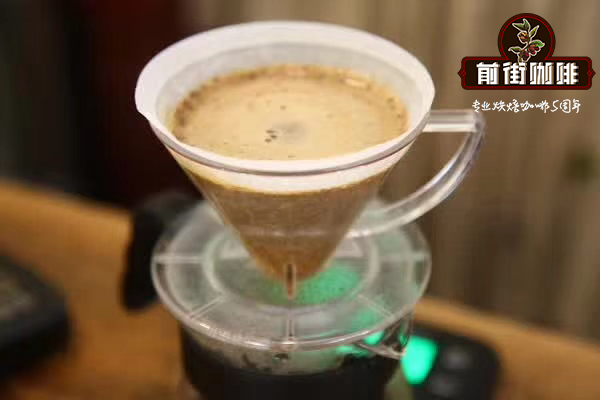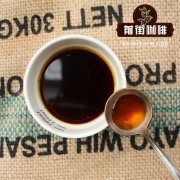The principle of extraction of Coffee the principle of extraction of Coffee by hand

Professional coffee knowledge exchange more coffee bean information please follow the coffee workshop (Wechat official account cafe_style)
When extracting coffee, put the ground coffee powder into the filter cup and inject water carefully. The first time to inject a small amount of water, and rest until soaked in coffee powder, and then divided into 3 to 4 times of water injection (there is also an one-time water injection). Why do we have to divide these steps? This is because the principles of dissolution and diffusion are used to extract coffee.
When extracting coffee, if you carefully observe the filter cup, you can see the changing process of coffee, which plays a reference role in the extraction of coffee. However, the filter paper in the filter cup can not directly see the changes inside, so prepare a set of transparent utensils similar to the filter cup. So how is dissolution and diffusion carried out during extraction?
The core principle of hand-brewed coffee is that during roasting, chemical reactions take place inside the coffee cells to produce a variety of ingredients that emit the aroma and flavor of coffee. As a by-product of these chemical reactions, the gas slowly formed inside the coffee causes the cells to expand. These gases and water are expelled through very small pores inside the cell. These countless pores contain the ingredients that dominate the flavor of coffee formed during baking. To dissolve these ingredients, you must first crush the coffee beans and expose as many pores inside the coffee bean cells to the surface as possible. Then slowly inject water to dissolve the ingredients of the coffee, which is called dissolution.
In order to dissolve smoothly, we can consider grinding the coffee powder to the finest so that all the ingredients in the cell can be dissolved. However, if you grind it too fine, it is easy to block the filter paper, so in actual extraction, the coffee powder is only ground to the size of sesame grains. In this way, some cells containing coffee are exposed to the surface, while others are not exposed to the surface. There are also some cells that contain coffee ingredients that cannot be broken by crushing. These cells cannot be extracted by dissolution, and the extraction can only be formed by diffusion.
Put the coffee into a filter cup, fill it with a small amount of water until it is soaked, and the coffee begins to expand. This is because hot water soaks into the coffee cells along the capillaries between the coffee cells formed during baking, pushing the gas out of the cells, causing the coffee to expand.
The water that enters the coffee cell begins to dissolve the coffee ingredients and form a thick coffee solution. Stand still for a while and then inject water into the filter cup again, when there is a concentration difference between the solution formed in the coffee cell and the newly injected water, and the thick coffee solution begins to push the coffee ingredients into the newly injected water. This process is called diffusion.
In this way, in order to dissolve more smoothly and fully form the diffusion caused by the difference in concentration, the process of formal extraction and holding for 30 to 40 seconds after the first injection of water in the coffee cell is called pre-extraction (also known as steaming). In this process, coffee has been fully prepared for extraction.
The secret lies in the uniform contact between coffee and water. If you look at the roasted coffee beans under the microscope, you will find that there are many small holes. Because of this porous structure, the coffee powder will float on the surface when injected with water.
A close look at the coffee powder floating on the water shows that it has been divided into two layers. The bottom layer because the coffee powder is in full contact with water, resulting in the active dissolution and diffusion of coffee ingredients, but the upper layer is mixed with the gas discharged from the coffee, so the coffee is not in full contact with water. So even if you put in enough coffee powder, some of the coffee ingredients can't be completely dissolved.
In order to fully form dissolution and diffusion, the coffee is filled with water and sometimes stirred in the filter cup with a spoon. Stir with a spoon and mix the layered parts again so that the coffee and water can be fully contacted. If you inject water more carefully, you can stir it without a spoon, and the coffee powder can be in full contact with the water.
It is often heard that water injection should be carefully controlled in order to avoid the collapse of the coffee layer. But as you can see in the picture, no matter how fine the water is injected into the coffee powder floating on the water, the falling water still has an impact on the coffee layer on the surface, causing the coffee to sink to the bottom and then rise to the surface again. Because of this phenomenon, coffee and water can be fully and evenly contacted.
Water injection itself is to fully stir the water and coffee, so as long as the water and coffee can be fully mixed, regardless of the method of water injection, it does not have much effect on the taste of coffee.
Important Notice :
前街咖啡 FrontStreet Coffee has moved to new addredd:
FrontStreet Coffee Address: 315,Donghua East Road,GuangZhou
Tel:020 38364473
- Prev

How is coffee extracted? What is Coffee Extract?
Professional coffee knowledge exchange More coffee bean information Please pay attention to coffee workshop (Weixin Official Accounts cafe_style) Coffee extraction principle core process: 1 crush coffee beans to increase the surface area of coffee in contact with water; 2 fully soak coffee powder in aqueous solution, coffee essence hydrophilic dissolution; 3 separate coffee solution and coffee grounds. Coffee extraction principles All modern coffee extractions
- Next

How long does it take for a zero-basic barista to learn to make coffee? Where should I learn to make coffee in Wuyi area?
Professional coffee knowledge exchange more information about coffee beans Please follow the coffee workshop (Wechat official account cafe_style) in Europe, Korea, Taiwan and other places, there are almost as many coffee shops as convenience stores. This atmosphere is also gradually affecting Hong Kong, and many young people dream of opening a leisure coffee shop of their own. But the job of a barista is by no means easy. A cup of coffee.
Related
- Beginners will see the "Coffee pull flower" guide!
- What is the difference between ice blog purified milk and ordinary milk coffee?
- Why is the Philippines the largest producer of crops in Liberia?
- For coffee extraction, should the fine powder be retained?
- How does extracted espresso fill pressed powder? How much strength does it take to press the powder?
- How to make jasmine cold extract coffee? Is the jasmine + latte good?
- Will this little toy really make the coffee taste better? How does Lily Drip affect coffee extraction?
- Will the action of slapping the filter cup also affect coffee extraction?
- What's the difference between powder-to-water ratio and powder-to-liquid ratio?
- What is the Ethiopian local species? What does it have to do with Heirloom native species?

